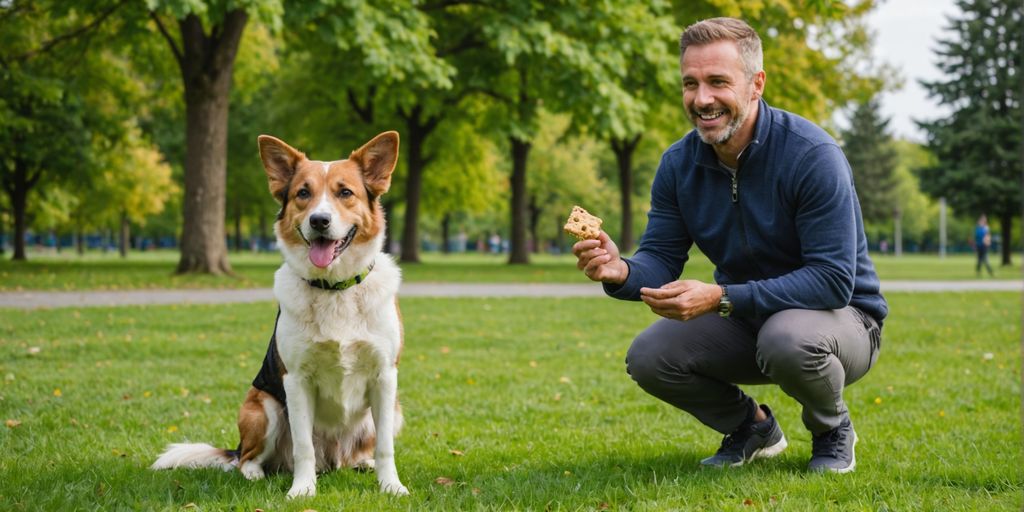Training your dog can be a fun and rewarding adventure for both of you. It's more than just teaching commands; it's about building a strong bond and understanding each other better. This article will cover key tips and techniques to help you master dog obedience training, making sure your pet is happy and well-behaved.
Key Takeaways
- Consistency is crucial in dog training for effective learning.
- Positive reinforcement encourages good behavior and strengthens your bond.
- Basic commands like ‘sit' and ‘stay' are the foundation of obedience training.
- Early socialization helps dogs feel comfortable in different environments.
- Patience and practice are essential for overcoming training challenges.
Building a Strong Foundation: The Basics of Dog Obedience Training
Understanding Your Dog's Behavior
Before diving into training, it's crucial to understand your dog's behavior. Dogs communicate through body language, and recognizing these signals can help you tailor your training approach. For example, a wagging tail often means happiness, while a tucked tail can indicate fear. By understanding these cues, you can create a more effective training plan.
The Importance of Consistency
Consistency is key in dog training. Dogs thrive on routine, so it's essential to use the same commands and rewards each time. This helps your dog understand what is expected of them. Consistency not only makes training easier but also helps in building trust between you and your dog.
Positive Reinforcement Techniques
Positive reinforcement is one of the most effective training methods. This involves rewarding your dog for good behavior, which encourages them to repeat those actions. Rewards can be treats, praise, or playtime. By associating good behavior with positive outcomes, you're not only encouraging your dog to repeat those behaviors but also fostering a sense of trust and cooperation.
Remember, every dog learns at their own pace. Celebrate small victories and be patient with your furry friend. Training is not just about teaching commands; it's about building a trusting and loving relationship.
Essential Commands Every Dog Should Know
Teaching ‘Sit' and ‘Stay'
Teaching your dog to ‘Sit' and ‘Stay' forms the foundation of good behavior. Start with ‘Sit' by holding a treat close to your dog's nose and moving your hand up. This will make their bottom lower to the ground. Once they sit, say "Sit" and give them the treat. For ‘Stay,' have your dog sit, show your palm, and say "Stay." Take a step back, and if they stay, reward them. Gradually increase the distance and duration.
Mastering ‘Come' and ‘Leave It'
The ‘Come' command is crucial for your dog's safety. Use a leash and gently pull them towards you while saying "Come." Reward them when they reach you. For ‘Leave It,' show them a treat in your hand and say "Leave It." When they stop trying to get it, reward them with a different treat. Consistency is key to mastering these commands.
Advanced Commands for Well-Rounded Training
Once your dog has the basics down, you can move on to advanced commands like ‘Heel,' ‘Wait,' and ‘Drop It.' These commands help in various situations, making your dog more adaptable and well-behaved. Positive reinforcement remains essential, so always reward good behavior. Advanced training not only improves obedience but also strengthens the bond between you and your pet.
Remember, every dog learns at their own pace. Celebrate small victories and be patient with your furry friend. Training is not just about teaching commands; it's about building a trusting and loving relationship.
Leash Training: Enjoyable Walks with Your Dog
Choosing the Right Gear
Selecting the right gear is crucial for effective leash training. Here’s what you need:
- Sturdy Leash: A strong leash is essential for control.
- Harness vs. Collar: A harness is often better for beginners as it distributes pressure evenly and is safer for your dog’s neck.
- Comfortable Fit: Ensure the harness or collar fits well to avoid discomfort.
Step-by-Step Leash Training
- Start Indoors: Begin training inside your home where there are fewer distractions.
- Hold the treat in your right closed hand about 6 inches from your dog's snout. Begin walking at a normal pace and say “heel.”
- Move to the Yard: Once your dog is comfortable indoors, practice in your yard.
- Short Walks: Take short walks in a quiet area, gradually increasing the distance.
- Reward Good Behavior: Use treats and praise to reward your dog for walking calmly.
Common Leash Training Challenges and Solutions
- Leash Pulling: If your dog pulls, stop walking and wait until the leash is loose. Then, continue walking. Consistency is key to breaking this habit.
- Distractions: Practice in different environments to help your dog get used to various sights and sounds.
- Fear of the Leash: Let your dog wear the leash around the house to get used to it.
Remember, every dog learns at their own pace. Celebrate small victories and be patient with your furry friend. Training is not just about teaching commands; it's about building a trusting and loving relationship.
Socializing Your Dog for Better Behavior
The Benefits of Early Socialization
Socializing your dog early on is crucial. It helps them become comfortable around new people, animals, and places. Early socialization can prevent behavior problems like aggression and anxiety. A well-socialized dog is generally happier and more confident.
Introducing Your Dog to New Environments
When introducing your dog to new environments, start slow. Take them to different places like parks, pet stores, and friend's houses. Use positive reinforcement to reward good behavior. This helps your dog associate new experiences with positive outcomes.
Handling Socialization Setbacks
It's normal to face setbacks during socialization. If your dog shows signs of fear or aggression, take a step back and go slower. Patience is key. Remember, agility training, scent work, trick training, and even barkour can all be fun ways to help your dog build confidence and greet new challenges with enthusiasm.
"Unlock the Secrets to a Blissful, Healthier Puppy: Discover the Benefits of Holistic Housebreaking"
Consistency in socialization efforts will help your dog become more adaptable and well-behaved in various situations.
Addressing Common Behavioral Issues
Behavioral issues can disrupt the peace in your home. Knowing how to tackle these problems is a key part of dog training. Here are some common issues and how to address them effectively.
Fun and Engaging Training Games
Playing games with your dog is not just about fun; it's a fantastic way to build a stronger bond with your furry friend. These activities provide mental and physical exercise, helping your dog stay sharp and healthy. Plus, they offer a great opportunity for you to spend quality time together, deepening your connection. Here are some fun and engaging training games to try with your dog.
Housebreaking Tips for a Clean Home
Crate Training Basics
Crate training is a fantastic way to help your puppy learn to control their bladder. Think of the crate as your dog's personal den—a safe and cozy space where they can relax. Start by making the crate inviting with soft bedding and a few toys. Gradually increase the time your puppy spends in the crate, always rewarding them for calm behavior.
Establishing a Routine
Dogs thrive on routine, and housebreaking is no different. Take your puppy outside frequently, especially after meals, naps, and playtime. Consistency is key. Use the same spot in your yard each time, and praise your puppy when they go potty in the right place. This helps them understand what's expected.
Handling Accidents Gracefully
Accidents will happen, and that's okay! When they do, clean up immediately with an enzymatic cleaner to remove any lingering odors. Avoid scolding your puppy, as this can create fear and confusion. Instead, focus on reinforcing positive behavior.
Remember, patience and consistency are your best friends during the housebreaking process. Celebrate small victories and stay optimistic!
Conclusion
Training your dog is more than just teaching them to follow commands; it's about building a strong, loving bond. By using the tips and techniques we've discussed, you can help your dog become a well-behaved and happy member of your family. Remember, patience and consistency are key. Celebrate the small victories and enjoy the journey of learning and growing together with your furry friend. Happy training!
Frequently Asked Questions
What is the best age to start obedience training for my dog?
The best time to start obedience training is when your dog is a puppy, around 8 weeks old. However, dogs of any age can benefit from training.
How long should each training session be?
Keep training sessions short, around 10-15 minutes, to keep your dog's attention and prevent them from getting bored.
What should I do if my dog doesn't follow commands?
Be patient and consistent. If your dog doesn't follow a command, try breaking the task into smaller steps and use positive reinforcement to encourage them.
Can older dogs learn new commands?
Yes, older dogs can learn new commands. It might take a bit more patience, but with consistent training and positive reinforcement, they can learn just like puppies.
How do I stop my dog from barking excessively?
Identify the cause of the barking and address it. Use positive reinforcement to reward quiet behavior and teach commands like ‘quiet' or ‘enough'.
What is the best way to socialize my dog?
Expose your dog to different environments, people, and other dogs gradually. Positive experiences help them become more comfortable and well-adjusted.


